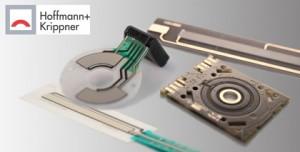物联网出现新神器:印刷聚合物传感器
本周,传感器博览会在加利福尼亚举行。Hoffmann和Krippner一起展示了基于印刷聚合物浆料的传感器可以作为精确测量物联网应用中的位置或压力。
制作该传感器的材料被称为SensoInk,可以打印成电位器、电阻、开关或键盘触点等电子元件。


Printed polymer sensors look like being the next big thing in IoT device technology.
At Sensors Expo in California this week Hoffmann+Krippner demonstrated how sensors based on printed polymer pastes can be accurate enough for IoT position or pressure sensors.
The sensor materials called SensoInk can be printed as potentiometers, resistors, switches or keyboard contacts on circuit boards or electronic components.
Only two components are required for signal transformation: a printed potentiometer track on a carrier material (e.g. FR4 or PET foil) and a conductive wiper.
The firm also has a membrane position sensor called Sensofoil, which is a thin-film membrane 0.5 mm to 1 mm thick.
It is available in lengths of 50 mm up to 500 mm, 40mm wide rotary. The supplier claims a repeat accuracy of 1mm to 10µm.
Jens Kautzor, CEO of Germany-based Hoffman+Krippner writes:
"To detect how the state of the internet-connected "thing" changes, an electronic evaluation of the initial state must be conducted. With our sensors you can accurately measure changes, detect positions, or count objects."
Another firm Thin Film Electronics has demonstrated a printed sensor for tagging bottles which can detect when a product is "sealed" and "open".
Likely to be used for tagging wine and spirits, pharmaceuticals, cosmetics and automotive fluids, the tag is designed to provide NFC-readability before and after a factory seal on the product has been broken.
According to the Norway-based company, it is possible to provide content to mobile devices on "sealed" or "opened" status, as the consumer’s context shifts from "pre-purchase" to "in use."
For example, a sealed product could trigger multimedia content to encourage a consumer purchase, while opened products could deliver messaging with usage tips and recommendations of complementary products.
An attraction of the printed NFC tags is that the can be produced at lower cost than traditional radio-frequency identification (RFID) devices, said Thin Film Electronics
Cambridge-based PragmatIC, which recently received a cash injection from investors such as ARM and CIC, said it has plans to broaden its circuit design activities, including applications such as sensors, processors and wireless communications.
PragmatIC has a production facility based at the National Centre for Printable Electronics in Sedgefield, is using the funding to hire more staff and to enable the scale-up of its production capacity to 100 million flexible integrated circuits later this year.
Pragmatic_Printing_11-300x199Scott White, CEO, PragmatIC (pictured right), says the company now has the funding to address the limitations of how robustly and cost-effectively create printed electronic devices for e-passports and other applications.
"Our technology platform creates a microcircuit thinner than a human hair that can be easily embedded in any flexible surface," said White.
According to Victor Christou, senior investment director of CIC, PragmatIC’s flexible electronics offers "the most compelling and cost effective product I’ve seen in the 20 years I’ve been involved in this industry."
编译,严禁转载!
以下是精选原创系列,从产业到八卦,从技术到深度观察都应有尽有,更多精彩,请进入观察室查看。
《显微镜下的嵌入式产业》
特邀嵌入式产业的践行者和观察家何小庆老师坐阵,为我们带来他对这
- 传感器和致动器正成为元器件市场新热(03-12)
- 图像传感器市场突破60亿美元,CMOS将占主导地位(05-22)
- 超低功率“智能尘埃”创新无限,无线传感器技术继续高歌猛进(05-22)
- 电化学气体传感器核心技术见突破(05-26)
- 日本工业机器人选中Cognex视觉传感器作为标准组件(04-14)
- 欧姆龙索能发力通用传感器市场,上海成立合资公司(05-08)
